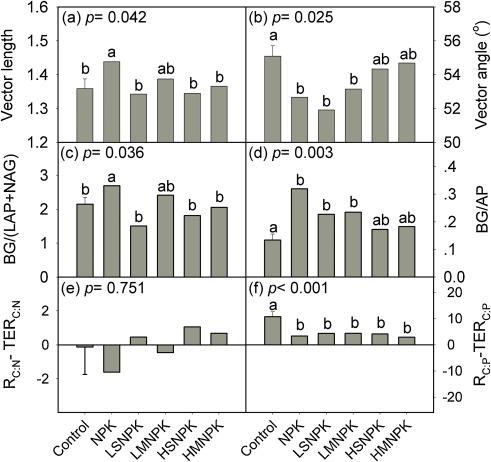
Microbes regulate many soil processes including carbon (C), nitrogen (N) and phosphorus (P) transformations. However, these microbial-controlled processes are strongly dependent on microbial biomass or activity, which is mostly limited by energy and nutrient availability.
The status of microbial resource limitation, however, can be altered in agro-ecosystems due to application of inorganic fertilizers and organic fertilizers (e.g. straw or manure) alone or in combination. Studying how soil microbial resource limitation changes under different fertilization strategies is important for identifying effective fertilization strategies to improve soil C sequestration and crop productivity in agro-ecosystems.
Researchers in the Institute of Subtropical Agriculture (ISA) of the Chinese Academy of Sciences investigated the effects of long-term (11 years) fertilization on microbial resource limitation in a karst cropland under maize-soybean rotation to directly assess how microbial resource limitation status change under different fertilization strategies in agro-ecosystems. Their findings were published in Soil and Tillage Research.
The researchers assessed soil microbial resource limitation by enzymatic stoichiometry. Six fertilization strategies were included: no fertilization (control), inorganic fertilizers only (NPK), inorganic fertilizers plus a low amount of straw (LSNPK), inorganic fertilizers plus a low amount of manure (LMNPK), inorganic fertilizers plus a high amount of straw (HSNPK), and inorganic fertilizers plus a high amount of manure (HMNPK).
They found that soil microbes were not limited by N, but co-limited by C and P across the six fertilization strategies. However, the degrees of microbial resource limitations were different between the control and fertilizer treatments.
Application with inorganic fertilizers only aggravated microbial C limitation, but combined application of inorganic fertilizers and organic matters did not change the status of C limitation relative to the control. None of the fertilizer treatments changed the status of microbial N limitation.
The treatments of NPK, LSNPK and LMNPK alleviated microbial P limitation, but HSNPK and HMNPK had no significant effects on P limitation relative to the control.
By contrast, the crop production had no significant difference among all fertilizer treatments in the current study.
"Our results indicate that fertilizations can change microbial resource limitation status, which might be a more sensitive indicator to identify effective fertilization strategies relative to the crop production," said CHEN Hao, a doctoral researcher at ISA and corresponding author of the paper.
This study also suggests that karst croplands do not need too much N fertilizer due to the N-rich characteristic, and that combined inorganic and organic fertilization strategies are better than single fertilization strategy in karst croplands.

Effects of fertilizations on indicators of microbial resource limitation. (Image by CHEN Hao)

86-10-68597521 (day)
86-10-68597289 (night)

52 Sanlihe Rd., Xicheng District,
Beijing, China (100864)

